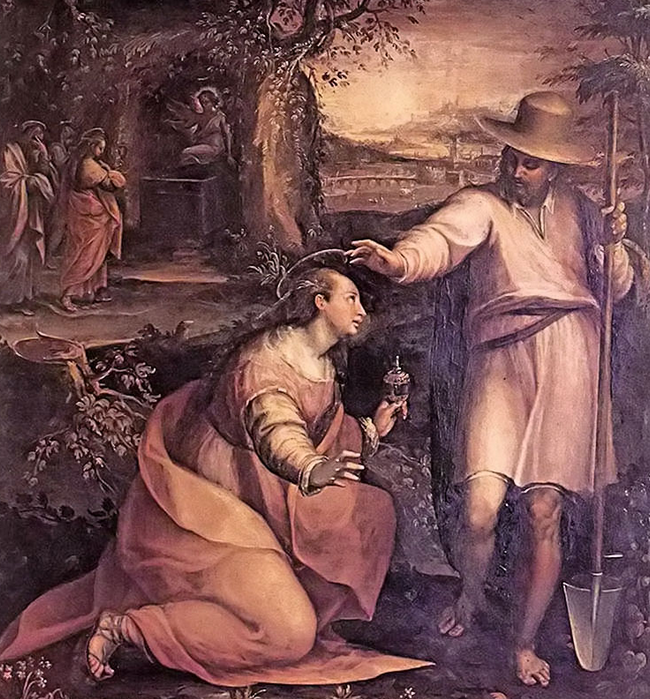Then we get to a beautiful room I have to say of works
接下來我們來到這個美麗的房間
devoted to the arts of child birth
這里擺放的都是關于新生兒的藝術品
And there we have both these birth trays
這里有慶生盤
the first one I showed you was that made for Lorenzo de' Medici
剛才我展示的第一個慶生盤是來自洛倫佐·德·美第奇的
The one on the left here which is a sort of transitional kind of object
左邊這個處于過渡時期的作品
between a tray and a bowl by the great Florentine artist Jacopo Pontormo
介于盤子和碗之間的是佛羅倫薩藝術家雅科波·蓬托莫的作品
And also a number of paintings that show babies stored in the 15th century
這里有一些十五世紀時期的嬰兒畫作
and then gather speed in the 16th century
還有許多十六世紀的

And on the right you see one from Bolonia by the woman artist Lavinia Fontana
右邊是來自博洛尼亞的拉維妮婭·豐塔納的作品
A lot of discussion amongst the organizing committee about whether this
關于這幅畫是用來慶賀新生兒的誕生
is a commemorative portrait of a child who is alive
還是用來紀念去世的孩子
or in fact it's a posthumous portrait
存在很多爭議和討論
It could go either way It's very interesting and open question
兩種假設都有可能,這是個有趣的開放性問題
Then we get into Linda's section
下面的部分將由琳達講解
She's more comfortable talking about it than I am
雖然她比我更擅長于此
but I'll give it a stab
但是我還是要試一試
This is a plate a very important piece of ceramics of 1536
這是一個盤子,一個于1536年制造的非常重要的陶瓷制品
which is called for obvious reasons the Phallic Plate
它的名字,顯而易見地,叫做生殖崇敬盤
before the fact in which the whole head
事實上這個作品中
is made up of these thriving intertwining phalluses
整個人的頭部都是又相互纏繞的陽物構成
And the banderol again like the banderols we saw in those
上面的小旗,我們之前看到的說明
early objects that were made to celebrate marriages
寫得都是這是件慶祝婚禮的藝術品
here instead it's a commentary that reads this way
但是這個不一樣
So there's something very secret about this man to be understood
關于這個男人有一些秘密
only by those who are in on the joke really
只有懂他的人才能明白
which says "I don't know why everyone calls me a dickhead"
小旗上寫著“我不知道為什么大家都叫我白癡“
But what I want I hope you all go in explore this section on your own
我希望大家在聽完講解后能夠自己去探索一下這些作品
But I want to leave you with the ideas that are at the core of it
這里我想將這次展覽的主題留給你們自己去挖掘
which is that erotic art was not a preferential theme in the Renaissance
情色藝術并不是意大利文藝復興時期的優先主題
but in fact was taken on by some of the greatest artists
并且只有那些特別偉大的藝術家才會涉及這個主題
who were working at the time: (Julia Romano Prensa Del Vaga Pome Genino)
包括茱莉亞等等
and maybe you will notice that many of these artists are connected
你們可能注意到了大部分藝術家都相互認識
through linked through their association with Raphael's workshop
他們通過拉斐爾的工作室認識彼此
And in around 1520 there seems to be something about that particular
在1520年左右,羅馬的文化運動
cultural moment in Rome which was inspirational to these artists
似乎啟發了這些偉大的藝術家們
And Linda thinks I'm sure she's absolutely right that there's something
我贊同琳達的看法
about the wit and the satire and the subversive quality of these
就是這些作品中流露出的機智,嘲諷,顛覆性的思想
works of art that tie it to this Roman culture
都跟羅馬文化脫不了干系
that then gets to fused throughout Italy
這些思想隨后點燃了整個意大利











